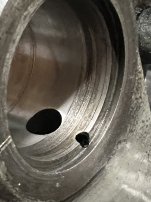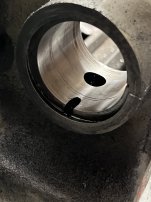KIBarrister
Plastic
- Joined
- Oct 18, 2023
Hello from the People's Republic of Marylandistan!
I'm new around here, and come to metalworking as a hobby (started off learning TIG welding to build an HK Roller Lock project several years ago). I briefly learned how to use a lathe 20+ years ago, but after more than a couple concussions and simple passage of time... I know very little. I acquired a South Bend Model A (circa 1962 I believe) to take the next step a few other 2A projects. I have changed it to an AXA tool post, replaced the brass cross feed nuts (that took back lash to something workable, if not down right respectable), and broke down the apron to clean and replace wicks. Replaced the original 3 phase motor with a single phase 220 (but kept it, I may add VFD down the line - for right now, I don't need that much control and electrical wiring is the fastest way to make my head spin). Replaced what seemed to be overly thin conveyor belting with a purpose built proper belt off eBay (along with the rebuild "kit" and manual). I have some projects to do and would rather not spend inordinate time renovating when my goal is to use - but, after serving for 60 years, I also don't want to be the dummy that kills this lathe (it looks to have lived it's entire life in a mold making shop in New England).
My most immediate question is on the spindle.
I have seen a few other posts here while looking for my answer. Some have said, do it to inspect it and replace the felts; others have said "if it ain't broke don't touch it" (paraphrasing). The front bearing is at .002 when testing with a dial indicator. The rear spindle bearing is .0035. Oddly, when adding oil, the front bearing seems to soak it up and need refilling - but after 5 or so hours of running the lathe the rear spindle bearing does not seem to have gone through any oil. The felts I have replaced were dirty, but still seemed to be serving their function. No noticeable heat or noise is coming off the spindle. Should I break it down and replace the felts (which I have), or run with it? It also seems the runout is at a point where removing one of the shims would be appropriate (if only barely - the spindle bolts are tight though).
I have already managed to turn a couple of my immediate need parts (e.g. an aluminum heat sink pin for welding up a hole to spec - tried copper and quickly found it doesn't play as easily as steel), and fabricated a KISS spider for the back end of the spindle. I have a 3 jaw and face plate that came with it. I bought an import four jaw, but I am having a devil of a time machining the face plate - the "chips" come off as fine powder (whether using HSS, brazed carbide, or inserts). IIRC, this means it is cast iron? The backplate seems to be "universal" and as a result needs to be turned down quite a bit (1" + in radius).
The only item I've been "burned" on is a steady rest. I picked up one on Ebay that was labeled as 9" (and had SB markings) but upon receipt it appears to be off a larger model that someone 'cut' to fit the ways and sits about an inch too high.
Any insight that can be offered on addressing the spindle (or not) would be appreciated! Bonus points if anyone has suggestions for this backplate...
K
I'm new around here, and come to metalworking as a hobby (started off learning TIG welding to build an HK Roller Lock project several years ago). I briefly learned how to use a lathe 20+ years ago, but after more than a couple concussions and simple passage of time... I know very little. I acquired a South Bend Model A (circa 1962 I believe) to take the next step a few other 2A projects. I have changed it to an AXA tool post, replaced the brass cross feed nuts (that took back lash to something workable, if not down right respectable), and broke down the apron to clean and replace wicks. Replaced the original 3 phase motor with a single phase 220 (but kept it, I may add VFD down the line - for right now, I don't need that much control and electrical wiring is the fastest way to make my head spin). Replaced what seemed to be overly thin conveyor belting with a purpose built proper belt off eBay (along with the rebuild "kit" and manual). I have some projects to do and would rather not spend inordinate time renovating when my goal is to use - but, after serving for 60 years, I also don't want to be the dummy that kills this lathe (it looks to have lived it's entire life in a mold making shop in New England).
My most immediate question is on the spindle.
I have seen a few other posts here while looking for my answer. Some have said, do it to inspect it and replace the felts; others have said "if it ain't broke don't touch it" (paraphrasing). The front bearing is at .002 when testing with a dial indicator. The rear spindle bearing is .0035. Oddly, when adding oil, the front bearing seems to soak it up and need refilling - but after 5 or so hours of running the lathe the rear spindle bearing does not seem to have gone through any oil. The felts I have replaced were dirty, but still seemed to be serving their function. No noticeable heat or noise is coming off the spindle. Should I break it down and replace the felts (which I have), or run with it? It also seems the runout is at a point where removing one of the shims would be appropriate (if only barely - the spindle bolts are tight though).
I have already managed to turn a couple of my immediate need parts (e.g. an aluminum heat sink pin for welding up a hole to spec - tried copper and quickly found it doesn't play as easily as steel), and fabricated a KISS spider for the back end of the spindle. I have a 3 jaw and face plate that came with it. I bought an import four jaw, but I am having a devil of a time machining the face plate - the "chips" come off as fine powder (whether using HSS, brazed carbide, or inserts). IIRC, this means it is cast iron? The backplate seems to be "universal" and as a result needs to be turned down quite a bit (1" + in radius).
The only item I've been "burned" on is a steady rest. I picked up one on Ebay that was labeled as 9" (and had SB markings) but upon receipt it appears to be off a larger model that someone 'cut' to fit the ways and sits about an inch too high.
Any insight that can be offered on addressing the spindle (or not) would be appreciated! Bonus points if anyone has suggestions for this backplate...
K




